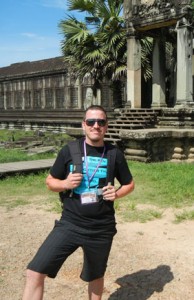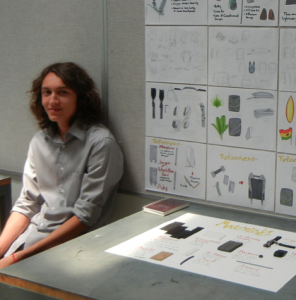Jeffrey Jones, a senior designer for Samsung Design America’s mobile unit, spends his days designing smartphones like the Galaxy Mini and the Corby II, but on Saturdays he teaches Introduction to Product Design at Saturday High, Art Center College of Design’s program for high school students (grades 9 through 12).
Jones—who studied at Art Center at Night and went on to earn a B.S. in Product Design at the College in 2007—was first turned on to the field of Product Design at Pasadena City College, where he took a class taught by Art Center instructor and alumnus Stan Kong PROD ‘83. While at Art Center, Jones interned at Vans, where he designed skateboarding equipment for the Vans Equipment Group, under the leadership of Art Center alumnus, Safir Bellali TRANS ‘01.
Before being hired by Samsung, Jones freelanced for Boombang, a creative think tank led by another Art Center alumnus, Tylor Garland PROD ‘94, where he worked on the design of two video game accessories—a fishing rod for The Strike and a rifle for The Hunt—for outdoor retailer Bass Pro Shops.
We recently caught up with Jones to learn more about his Saturday High class.
Dotted Line: Tell me about Introduction to Product Design.
Jeffrey Jones: Last term was the first time I taught the class, so I’m still fine-tuning it, but essentially it’s a 10-week course that I’ve broken up into three phases: the research phase, where students figure out what kind of product to design and for whom they’re designing; the ideation phase, where students develop their ideas, push the envelope, and select their very best concepts; and the refinement phase, where they further develop their best idea and present to the class exactly what their product is and how it works. I invited Joonsuh “Justin” Kim, the director of Samsung Design America to attend the final, and he sat in as a guest crit.
Dotted Line: Tell me more about the research phase.
Jones: The research phase is a big chunk of the class; it takes up the first four weeks. The reason I stress it so much is because it’s the phase where all the discovery, figuring out and planning happens. Last term I told my students about an “inspiration trip” Samsung sent me on, where I visited seven different countries in two weeks. I went to Cambodia to see the temples at Angkor Wat; I stayed at the Marina Bay Sands hotel in Singapore and enjoyed its crazy infinity pool in the sky; and I saw the fjords of Norway, which were pretty spectacular.
Dotted Line: And this was all tied to research?
Jones: The purpose of the trip wasn’t to send me on vacation. It was about letting me experience something incredible—like a tree growing on top of a temple in Angkor Wat—becoming inspired and bringing that back with me to create a detail for the next killer phone. I asked my class if they thought Samsung would be willing to invest that much money for me to have that experience if it wasn’t important. Research is what gives you all the ammunition for your design.
Dotted Line: Do students come into this class with an art background?
Jones: Some have been taking art classes their whole life; for some, this might be their second or third Saturday High class. But I structure the class in such a way that ideas are king, so the level of the students is not important. If a student has an amazing idea for a product but can’t sketch well, they could still have a successful project if they’re showing intelligent thinking, solving problems based on real-world issues, and finding ways to improve products and people’s lives through design.
Dotted Line: Drawing is also quite different from the three-phase process you’re teaching.
Jones: That process is definitely new to all the students. The drawing part is essentially visual communication, that’s all it is. The students all have their own style and I let them do their own thing. I’m always going to try to improve their skills, but I don’t make it the emphasis of the class.
Dotted Line: That’s something your former student Lana Vong mentioned she appreciated, the fact that you weren’t forcing her to alter her style.
Jones: I figure visual communication is an aspect of design that you’re going to continually work on if you want to be a product designer. I tell my class that when it comes to drawing, a pencil and paper is the same as a nail and a piece of wood. Anyone can learn how to hammer a nail into a piece of wood, but it’s what you build that separates you from everybody else. It’s the same with drawing. Anyone can learn how to draw and sketch, but it’s what you sketch that differentiates you from the guy sitting next to you. I want to be the kind of instructor that I had when I was in school, and I want to treat this class the same way a product design class is structured at Art Center. Which means that when you’re in class, you’re talking about your concepts, your ideas, your research and your process.
Dotted Line: Lana shared with us the foam sticker maker she designed in your class. What other kinds of projects did the students create?
Jones: This was my first class, and honestly, I was amazed. They all had some really cool ideas. I think Lana’s project was something that she could include in an Art Center entrance portfolio. During the research phase, one student decided to focus on simplifying the process of decorating trees in your front yard with Christmas lights. She came up with a lot interesting solutions, like attaching all the lights to a very lightweight netting that you could wrap around the tree with Velcro. She had another concept that worked like vines constructed out of removable and flexible metal rods—a newer technology that hardens when heated—that wrap around the tree in any direction you choose.
Dotted Line: That sounds pretty ambitious.
Jones: Yes, but I wanted them to stay realistic. That wrapping vine design could totally exist; it’s not blue sky at all. All the technologies she was looking at already exist. If you think of a typical production and development cycle and figure she’s trying to launch a product two years from now, it’s definitely feasible.
Dotted Line: What made you want to teach at Saturday High?
Jones: I wanted to get back to a more creative environment to both inspire some young kids—inspire them and help them discover this career I’m passionate about—and also to inspire myself. I’ve been working with Samsung for a couple years; it’s fun and I love it, but it’s not the same kind of fun I had when I was at Art Center. Art Center is a place where design thinking is king. I only get to design phones and electronics all day, but on Saturdays when I’m at school, I’m helping design Christmas tree lights and foam sticker makers.
Saturday High classes start this Saturday; register today!












